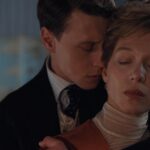Goon: Last of the Enforcers: Toothless, by David Bax
If you’re a fan of Michael Dowse’s shockingly great Goon (in other words, if you’ve seen Goon), you’ll probably be heartened by the opening scenes of Jay Baruchel’s Goon: Last of the Enforcers. The scenes of hockey are lively, the fights are bloody as hell and there are more utterances of “fuck” and its derivatives before the opening titles than most movies fit into their entire runtimes. After that, though, this sequel manages to be both slight and overstuffed, adding a bevy of unnecessary plot and characters while bringing nothing new to the ones that already exist.
It’s a few years later and Doug (Seann William Scott) is still playing for the Halifax Highlanders. He and bartender Eva (Alison Pill) are now married and expecting a baby, making this at least one of the unfortunately rare sequels where the male lead gets to be in love with the same person as at the end of the first one. When an up-and-comer who can score goals as effectively as he can throw punches (Wyatt Russell) gives Doug the beating of his life on the ice, Doug goes back to his old rival, Ross Rhea (Liev Schreiber), to train his way back into his old job.
Like its predecessor, Last of the Enforcers is packed with authentic touches that make it fan service to hockey acolytes (or maybe it’s just Canadian). Those who love hockey may well up at the inspirational stories like Gavin O’Connor’s Miracle but there’s another side to the sport, one that’s being slowly drained out of the NHL by rules regarding helmets, visors and the like that don’t actually ban fighting but make it more difficult to drop the gloves. Hockey is more than just a fast, brutal, vicious, violent game but, to many, it is those things too. Both Goon movies, despite their differences in overall quality, speak to a segment of the hockey community like no film has since 1977’s Slap Shot. Add to that some updated awareness of the dangers of concussions and unspoken moments like Russell standing directly on the logo on the floor of the locker room (hugely disrespectful) and you’ve got plenty in there for devotees to rally around. And that’s before we get to the numerous cameos from NHL players.
Last of the Enforcers’ expanded cast doesn’t stop there, either. In addition to Russell, Elisha Cuthbert is game as Eva’s lovable hot mess of a sister, T.J. Miller adlibs his way through the movie as a TV sports commentator with a terrible wig and Jason Jones shows up to turn in a go-for-broke performances as a hilariously crass insurance salesman. Still, the comedy of Goon is streaky. For every scene like the masterful one in which Kim Coates’ coach tries to give a profanely inspiring speech to the team while on a commercial flight, there’s something embarrassing like the gag where Doug’s inability to get up off a player he’s just knocked to the ice makes it look like he’s dry-humping the guy.
Baruchel, despite his surprisingly assured hand behind the camera, is the worst example of the movie’s exasperatingly incommodious comic tendencies. His best friend role has degenerated even further from the first film. Here’s, he essentially an R-rated version of Stiles from Teen Wolf, complete with a dumb hat.
Still, he probably has a future as a director, hopefully of better material. Goon: Last of the Enforcers’ main problem is an abundance of go-nowhere plotting. The film is set during an NHL (sorry, “big league”) lockout that doesn’t ultimately add anything to the story, which quickly gets bogged down with details of the team owner’s (Callum Keith Rennie) increasingly ludicrous personnel moves. The movie is apparently only nine minutes longer than its predecessor but it feels like 30. It’s like, instead of watching a hockey game, you chose to read the rule book.




























